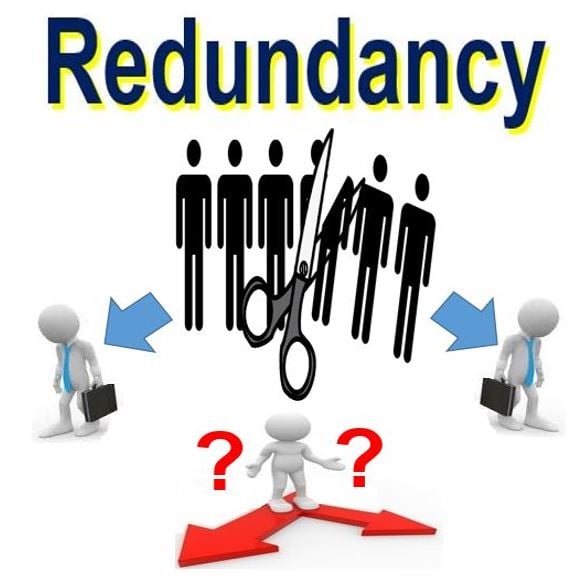If a Company Goes Bust Who Pays Redundancy? Legal Insights for UK Employees
If a Company Goes Bust Who Pays Redundancy? Legal Insights for UK Employees
Blog Article
Checking Out the Interaction In Between Company Redundancy and Business Adaptability for Future Development
In the vibrant landscape of today's company globe, the detailed partnership in between firm redundancy and business flexibility emerges as an important variable for continual growth and success. Firms typically deal with the obstacle of striking a fragile equilibrium between preserving a level of redundancy to alleviate dangers and promoting adaptability to respond swiftly to the ever-evolving market demands. This delicate interplay holds the key to not only surviving in rough times but additionally prospering when faced with uncertainty. As we explore the multifaceted dimensions of this interplay, appealing insights right into how companies navigate these complexities to pave the way for future growth await.
Significance of Business Redundancy
Business redundancy is an important component that improves business strength and alleviates functional threats. By including redundancy measures within the organizational framework, firms can much better hold up against unanticipated disruptions and fluctuations in the company environment. Redundancy serves as a tactical buffer, permitting business to adjust and respond effectively to unexpected obstacles without jeopardizing necessary procedures.
One trick aspect of the value of business redundancy is its function in making certain connection throughout times of crisis. When confronted with unexpected modifications or emergencies, repetitive systems, resources, or employees can tip in to keep important features and stop extensive disturbances. This connection not only safeguards the firm's track record and client trust yet also decreases economic losses and functional downtime.

Strategies for Business Versatility

Creating adaptable business structures that enable for fast changes to market dynamics and customer demands is essential for remaining competitive in a rapidly evolving environment. By proactively identifying potential disruptions and possibilities, organizations can proactively prosper and adjust in an ever-changing organization landscape.
Harmonizing Redundancy and Adaptability
Achieving a harmonious equilibrium in between functional redundancy and business flexibility is extremely important in browsing the intricacies of a dynamic service atmosphere. Redundancy within a business supplies a safeguard, making certain connection and stability in procedures. Nonetheless, an extra of redundancy can lead to ineffectiveness and prevent adaptability to altering market conditions. On the other hand, business versatility permits companies to respond quickly to outside interruptions and take brand-new possibilities. Striking the best balance between redundancy and adaptability is a fragile procedure that needs a deep understanding of the company's goals, industry characteristics, and threat resistance.
To accomplish this equilibrium, firms require to carry out routine analyses of their right here operations to identify areas where redundancy is needed for threat reduction and where versatility can drive innovation and development. Executing versatile structures, promoting a society of continual understanding and renovation, and urging open interaction across all levels of the organization are essential methods to integrate redundancy and flexibility successfully. By aligning these two vital aspects, business can position themselves for sustainable development and success in an ever-changing service landscape.
Case Researches on Adjustment Success
In taking a look at instances of effective business official source adjustment, it comes to be obvious that the interplay in between operational redundancy and versatility is a specifying element in forming resistant services. A DVD rental service, Netflix demonstrated exceptional versatility by transitioning right into a streaming platform when digitalization interrupted the sector. These instance research studies emphasize the significance of functional redundancy combined with business flexibility in cultivating long-term growth and competition.
Structure Strength for Future Growth
Building resilience for future development needs a strategic alignment of functional processes with market characteristics and emerging fads. Business have to adapt to transforming atmospheres by cultivating a society of adaptability, advancement, and constant improvement.
In addition, fostering solid relationships with stakeholders, such as clients, staff members, suppliers, and the community, is necessary for weathering unpredictabilities and preserving depend on and assistance throughout stormy times. Reliable interaction and openness play an important function in building resilience, as they help straighten assumptions and facilitate collaboration in navigating unpredictabilities.
In addition, organizations require to prioritize learning and advancement efforts to upskill workers and equip them with the required tools to adjust to altering circumstances. By spending in their workforce, companies can boost their versatility and dexterity, inevitably enhancing their resilience for sustainable future growth.
Verdict

In anonymous the dynamic landscape of today's business globe, the complex relationship between firm redundancy and organizational flexibility arises as a vital factor for continual development and success. Business commonly face the challenge of striking a fragile equilibrium in between maintaining a level of redundancy to reduce risks and promoting flexibility to respond swiftly to the ever-evolving market demands.To achieve this balance, companies need to perform normal evaluations of their procedures to identify locations where redundancy is required for threat mitigation and where adaptability can drive technology and growth.In verdict, the interaction in between business redundancy and business versatility is vital for future growth. Building strength with a mix of redundancy and flexibility will ensure that companies are prepared for the obstacles of the future.
Report this page